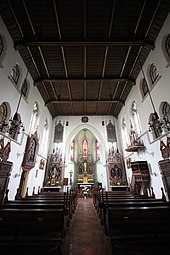Herz-Jesu Asylum Church
The Herz-Jesu-Asylkirche is structurally integrated into the Herz-Jesu-Heim in the Hübnergasse No. 5-7 in the district of Riedenburg in the municipality of Salzburg . The Roman Catholic religious order of the Cooperative of the Daughters of Christian Love of St. Vincent de Paul (Sisters of Mercy), consecrated to the Heart of Jesus , belongs to the city dean of Salzburg of the Archdiocese of Salzburg . The church is a listed building ( list entry ).
history
The neo-Gothic church was built in 1877/1878 according to the plans of the Viennese architect Friedrich von Schmidt with the master builder Vinzenz Rauscher and consecrated on November 3, 1878 by Archbishop Franz Albert Eder . The church was restored in 1974.
architecture
The church shows itself on the street front and on the courtyard side as an unplastered stone block and is flanked on both sides by plastered street sections of the Herz-Jesu-Heim retirement home. The street front shows itself with slightly recessed side wings, the central risalit-like front with two cornices indicates the two floors of the nave with a gallery and flat ceiling and has a grooved pointed arch portal in the middle, above three two-lane tracery windows, then a triangular gable with a facade tower.
The single-nave nave under a flat wooden ceiling is followed by a rib vaulted choir with a five-eighth end . The sides of the nave have two-lane tracery windows leading to oratorios on two floors. The triumphal arch is pointed, the triumphal arch wall shows the wall painting St. Vincent de Paul , Lamb of God , St. Johannes Gabriel Perboyre , painted by Josef Gold (1891). The choir windows have tracery noses, the glass painting was done by the painter Karl Weiser (1963).
Furnishing
The neo-Gothic altars are by the Salzburg cabinetmaker Johann Ripper, the figures were created by the sculptor Johann Piger . The figures on the high altar are the Heart of Jesus between Margareta Maria Alacoque and Theresia von Avila , Michael with Franz von Sales and Vincent von Paul in the process.
The left side altar bears the figures of Maria Immaculata , Luise von Marillac and Katharina Labouré , St. Anna and Angel. The right side altar carries the figures of hll. Joseph , Francis of Assisi and Antonius of Padua , John the Baptist in the midst between Peter and Paul .
The pulpit was created by the cabinet-maker Johann Ripper, and the figure of St. Paul (from Piger). As a counterpart to the pulpit there is a neo-Gothic relief of the Nativity in a neo-Gothic frame ( crib ) above the sacristy door , marked IE. Johann Piger (1881) created the reliefs of the cross.
The people's altar was created based on a design by the diocesan architect Peter Schuh (2004).
The first organ with six registers was built by Albert Mauracher (1889). In 1935, Hans Mertel expanded the organ to two manuals, 12 registers and a pneumatic cone loading system.
The three bells (tuning A, c, d) were cast by the Oberascher bell foundry (1948) in Salzburg Kasern.
literature
- Otto von Wallpach: Brief building history of the churches and public chapels of the city of Salzburg. Pustet, Salzburg 1882.
- The art monuments of Austria. Dehio Salzburg 1986 . Salzburg, Riedenburg, Herz-Jesu-Asylkirche, with floor plan, pp. 654–655.
- Lieselotte von Eltz-Hoffmann: The churches of Salzburg. Verlag Anton Pustet , Salzburg 1993, ISBN 3-7025-0308-0 .
- Hans Heuer: The Herz-Jesu-Kirche Salzburg Riedenburg. Description of the church, 1 page, in the church display case, without the year.
Web links
- Herz Jesu Heim - The Herz Jesu Church. Retrieved June 10, 2013 .
Coordinates: 47 ° 47 '54.8 " N , 13 ° 1' 55.8" E


